Several species of grouse inhabit my backyard (Wrangell/St. Elias National Park and Preserve), Alaska. Above, sharp-tailed grouse.
video link below: Grouse in my backyard

Several species of grouse inhabit my backyard (Wrangell/St. Elias National Park and Preserve), Alaska. Above, sharp-tailed grouse.
video link below: Grouse in my backyard
Check out my owl photos in June/July 2025 RANGER RICK by clicking link below.
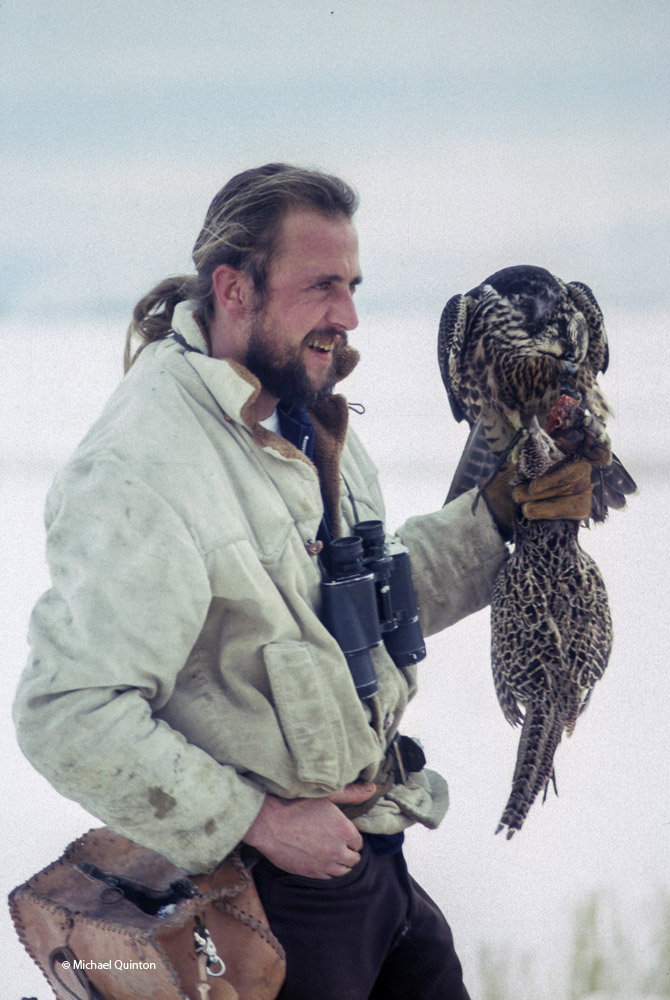 I couldn’t help but notice two hooded falcons perched on the back seat of a VW bug in the grocery store parking lot where I worked. ( forty-five years ago!) A guy with a ponytail drove it. When I said something about the prairie falcons, he looked a bit surprised. I guess nobody had ever correctly identified his falcons before. That’s how I first met Terry Heath. And with that introduction, we shared a short conservation that ended with Terry inviting me to photograph his hunting falcons. As I tagged along on hunting trips It became clear that for Terry, falconry was no hobby, nor was it just a sport hunting venture. No, Terry was in the grip of a full-blown obsession with falcons.
I couldn’t help but notice two hooded falcons perched on the back seat of a VW bug in the grocery store parking lot where I worked. ( forty-five years ago!) A guy with a ponytail drove it. When I said something about the prairie falcons, he looked a bit surprised. I guess nobody had ever correctly identified his falcons before. That’s how I first met Terry Heath. And with that introduction, we shared a short conservation that ended with Terry inviting me to photograph his hunting falcons. As I tagged along on hunting trips It became clear that for Terry, falconry was no hobby, nor was it just a sport hunting venture. No, Terry was in the grip of a full-blown obsession with falcons.
THE PRAIRIE FALCON
 Week-old prairie falcons huddle together on a simple scrape at their cliff eyrie. The aggressive divebombing adults give Terry a glimpse into the potential flight characteristics of the young falcons.
Week-old prairie falcons huddle together on a simple scrape at their cliff eyrie. The aggressive divebombing adults give Terry a glimpse into the potential flight characteristics of the young falcons.
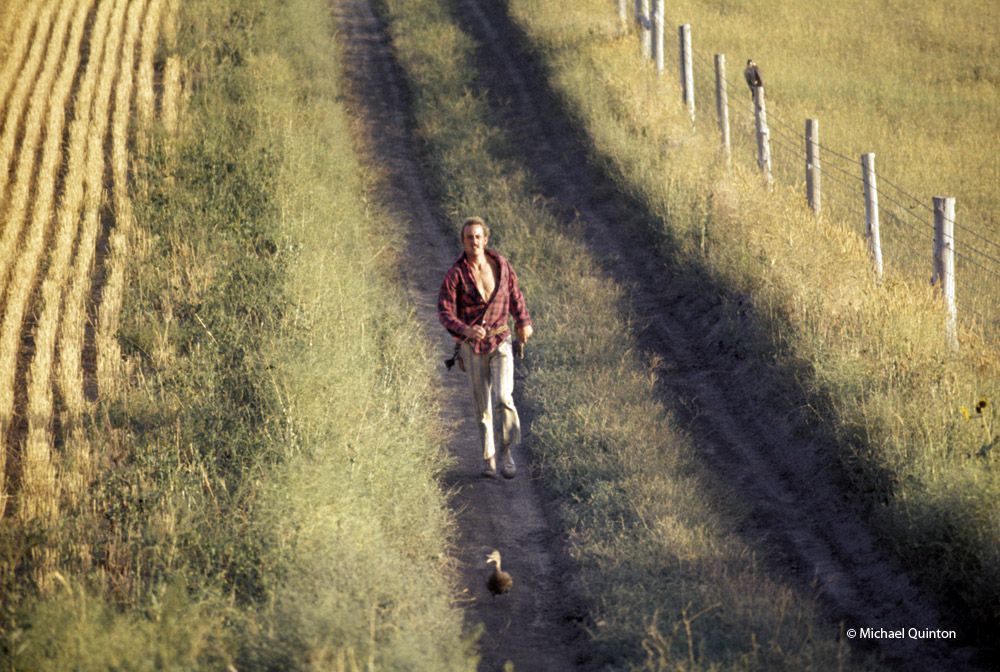 Early in her training, (above) the young female prairie falcon is content to sit on the sidelines and let Terry demonstrate. From such modest beginnings, the prairie quickly responds to training and will be introduced to wild pheasants and ducks soon. (below)
Early in her training, (above) the young female prairie falcon is content to sit on the sidelines and let Terry demonstrate. From such modest beginnings, the prairie quickly responds to training and will be introduced to wild pheasants and ducks soon. (below)
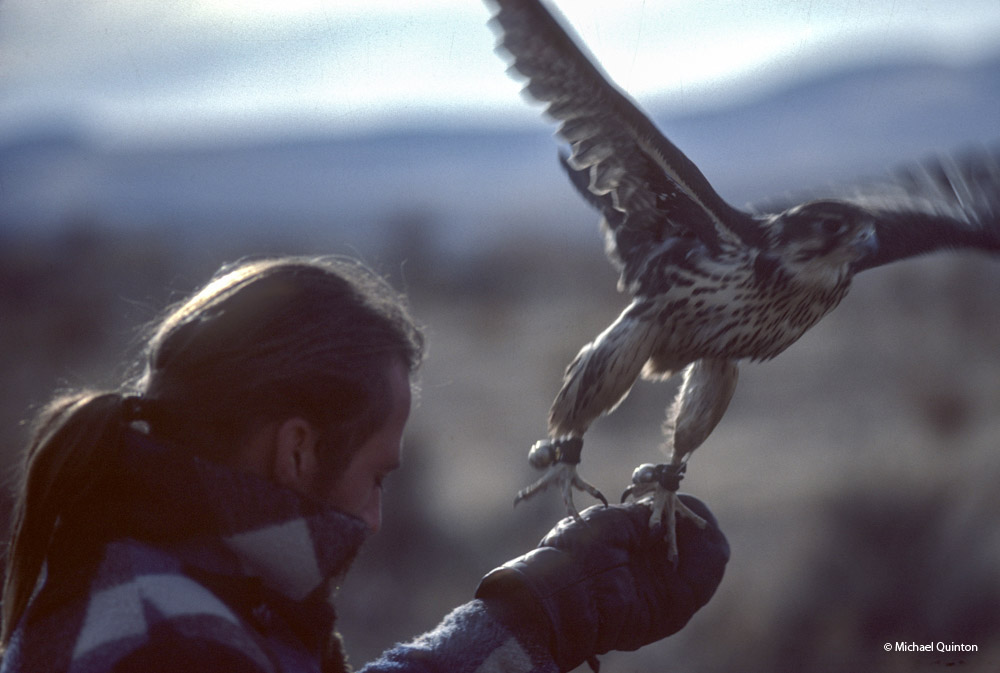 Casting off…
Casting off…
A PEREGRINE NAMED ANGEL
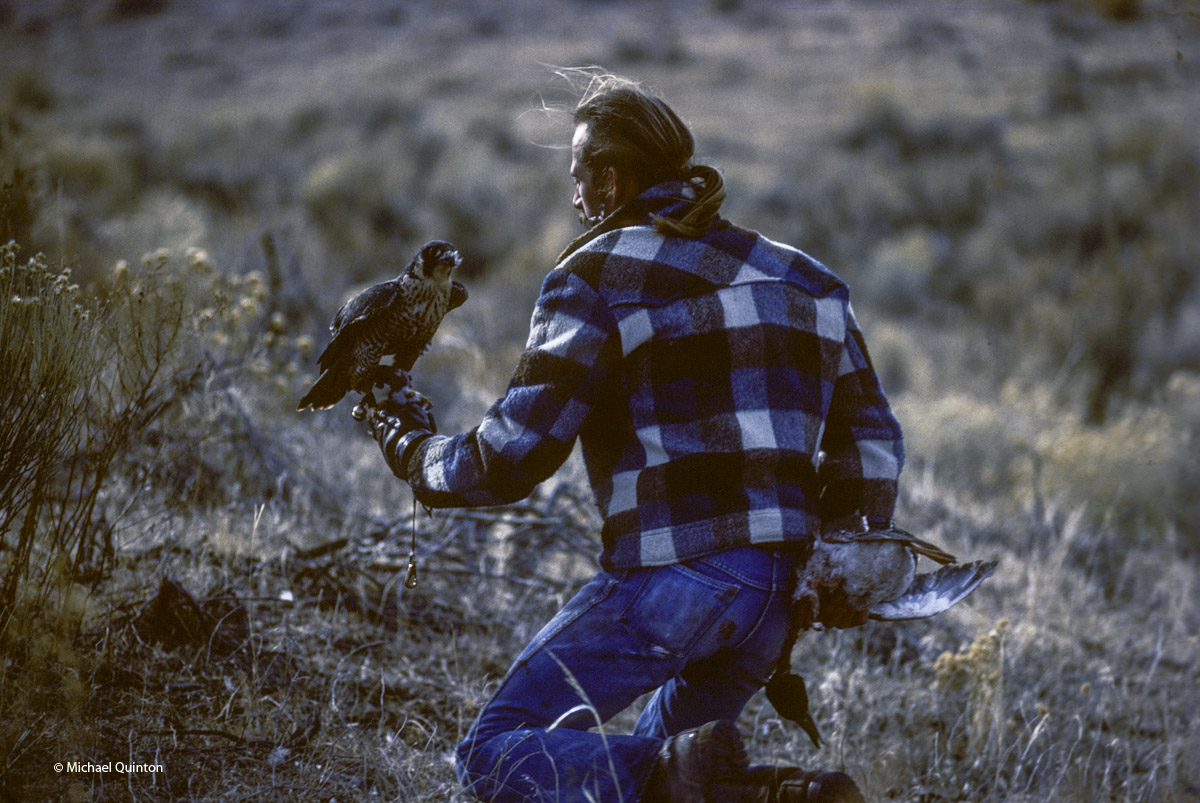 Another mallard for the bag. Every flight of Angel, the peregrine, was stunning,
Another mallard for the bag. Every flight of Angel, the peregrine, was stunning,
 Angel suddenly reappears out of nowhere to stoop on the lure. (above) For a few worrying minutes, Angel was nowhere to be seen. Had she made a kill out of sight? A big worry.
Angel suddenly reappears out of nowhere to stoop on the lure. (above) For a few worrying minutes, Angel was nowhere to be seen. Had she made a kill out of sight? A big worry. 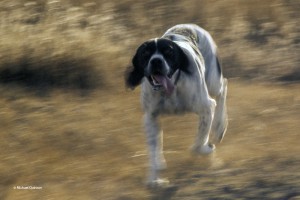 A falcon with a full crop is difficult to coax to the glove. Candy (right) was a fixture on the hunting trips. But once, after hawking for pheasants, Candy went missing and didn’t return to the car. Before leaving Terry threw out his coat. The next morning there she lay, waiting.
A falcon with a full crop is difficult to coax to the glove. Candy (right) was a fixture on the hunting trips. But once, after hawking for pheasants, Candy went missing and didn’t return to the car. Before leaving Terry threw out his coat. The next morning there she lay, waiting.
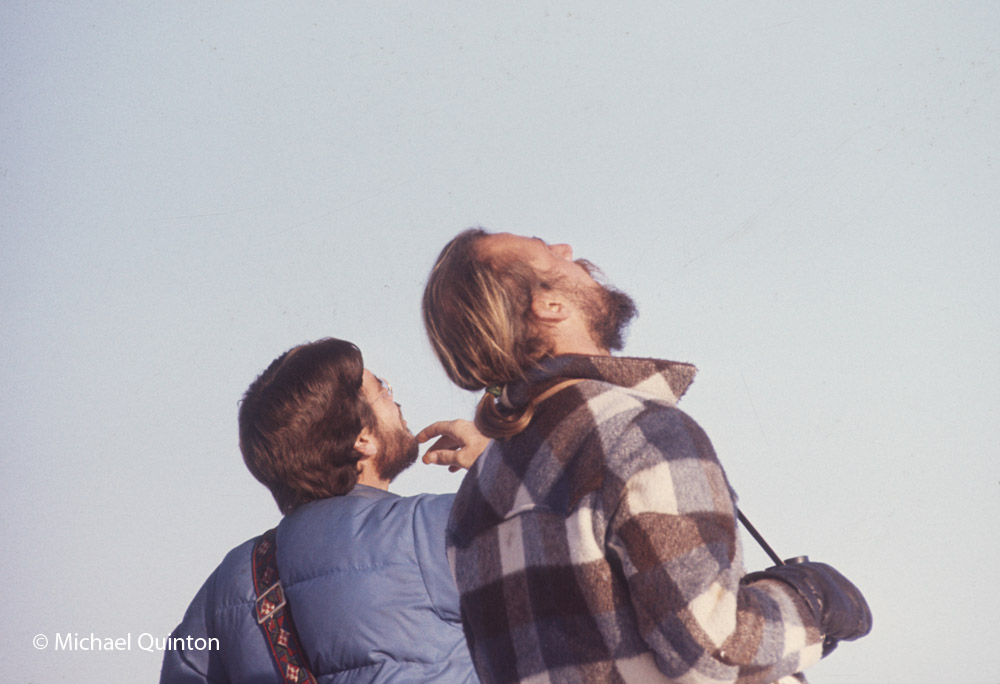 Searching for suitable quarry for the falcons led us out to the edge of the lava flows of eastern Idaho. Passing a pair of ravens hanging out along the road, Terry slows and pulls over a couple of hundred yards down the road. Stepping out of the van Terry removes the peregrines hood and lifts the falcon above his head. In an instant, the peregrine is off the glove and power-pumping those long, slender wings into the wind towards the dumb-struck ravens. From a jump start, the ravens took flight and started to climb. Now, these ravens share the sky with all kinds of raptors from goshawks to golden eagles so the sudden appearance of a peregrine is no big deal. But this one had them in the crosshairs! Though the peregrine’s power of flight is legendary, she could not outclimb the ravens. A peregrines advantage is on the way back down and the ravens knew it. The flight was quickly a quarter mile above the sage highlands and climbing. But the persistent peregrine wouldn’t give up. As the flight threatened to disappear, out came the lure.
Searching for suitable quarry for the falcons led us out to the edge of the lava flows of eastern Idaho. Passing a pair of ravens hanging out along the road, Terry slows and pulls over a couple of hundred yards down the road. Stepping out of the van Terry removes the peregrines hood and lifts the falcon above his head. In an instant, the peregrine is off the glove and power-pumping those long, slender wings into the wind towards the dumb-struck ravens. From a jump start, the ravens took flight and started to climb. Now, these ravens share the sky with all kinds of raptors from goshawks to golden eagles so the sudden appearance of a peregrine is no big deal. But this one had them in the crosshairs! Though the peregrine’s power of flight is legendary, she could not outclimb the ravens. A peregrines advantage is on the way back down and the ravens knew it. The flight was quickly a quarter mile above the sage highlands and climbing. But the persistent peregrine wouldn’t give up. As the flight threatened to disappear, out came the lure.
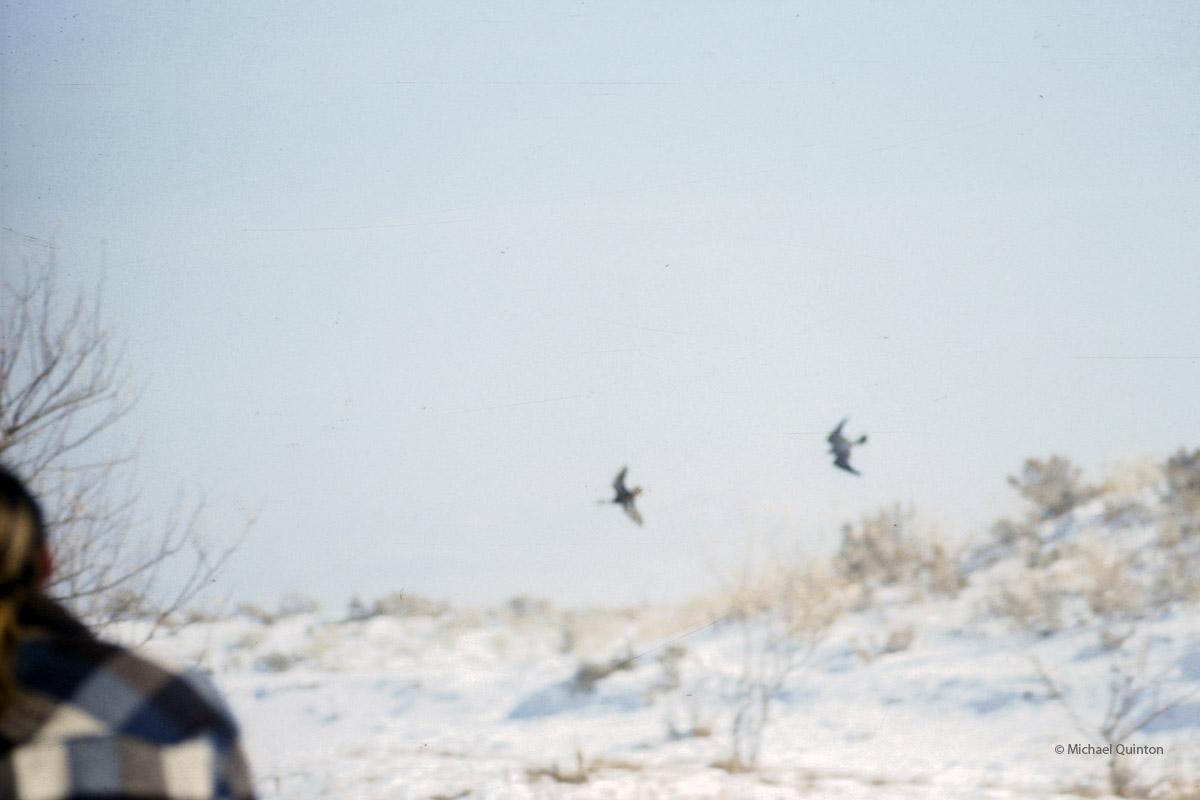 Desperate to get back to open water, the mallard deploys futile last-second maneuvers. The peregrines focus is clear. Mine, not so much.
Desperate to get back to open water, the mallard deploys futile last-second maneuvers. The peregrines focus is clear. Mine, not so much.
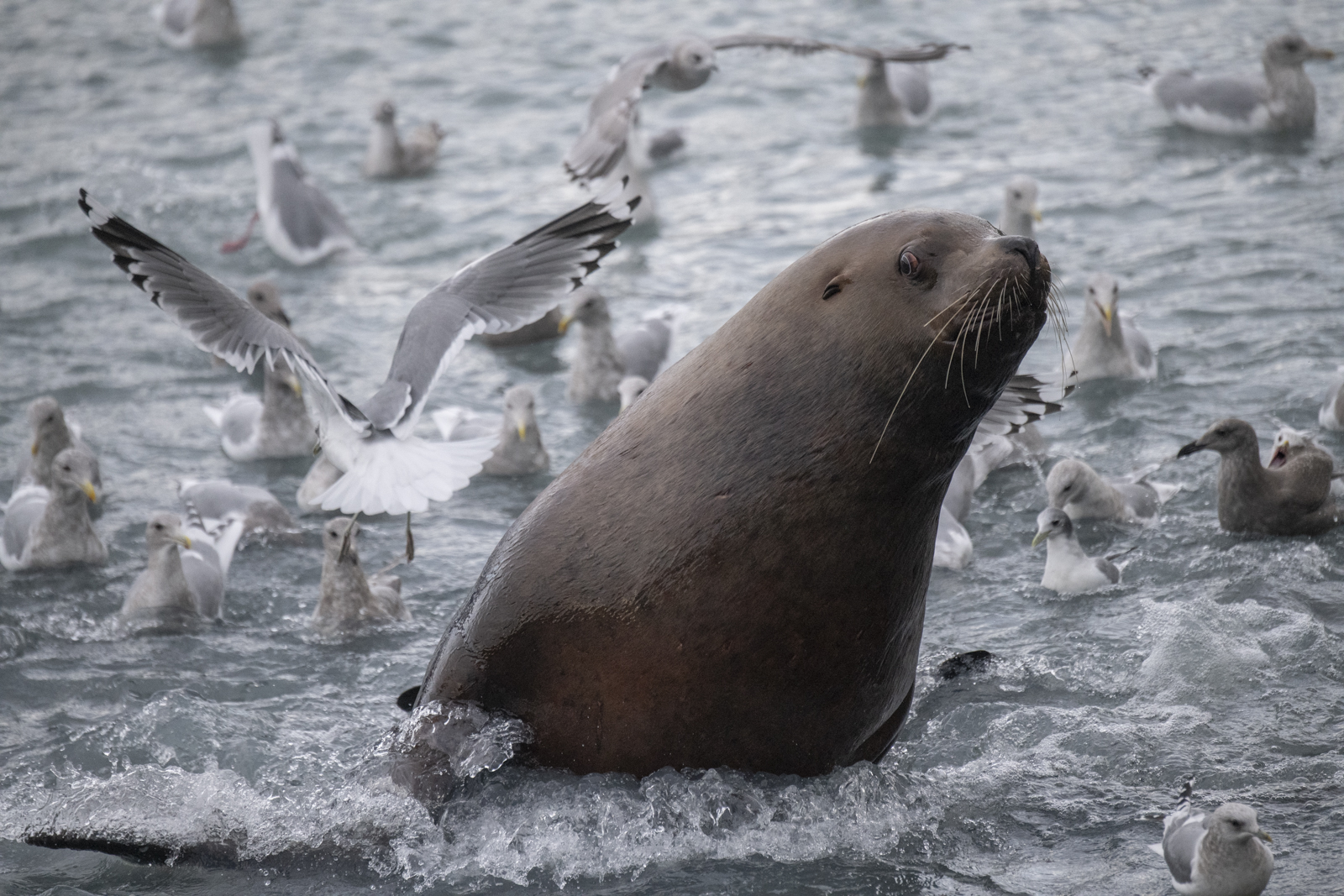 October 2021 A late-season run of coho salmon is attracting some enormous predators. At low tide, Steller’s sea lions leave the sea to follow the salmon into fresh water at the mouth of the shallow river. Some of the sea lions pick a spot to wait and watch. Some strike a bear-like pose as they watch for a salmon to swim past and then make a surprisingly quick lunge and grab the salmon. Others inch upstream with their heads underwater ready to grab any salmon within range of powerful bearlike jaws. And their appetite is Ridiculous!
October 2021 A late-season run of coho salmon is attracting some enormous predators. At low tide, Steller’s sea lions leave the sea to follow the salmon into fresh water at the mouth of the shallow river. Some of the sea lions pick a spot to wait and watch. Some strike a bear-like pose as they watch for a salmon to swim past and then make a surprisingly quick lunge and grab the salmon. Others inch upstream with their heads underwater ready to grab any salmon within range of powerful bearlike jaws. And their appetite is Ridiculous!
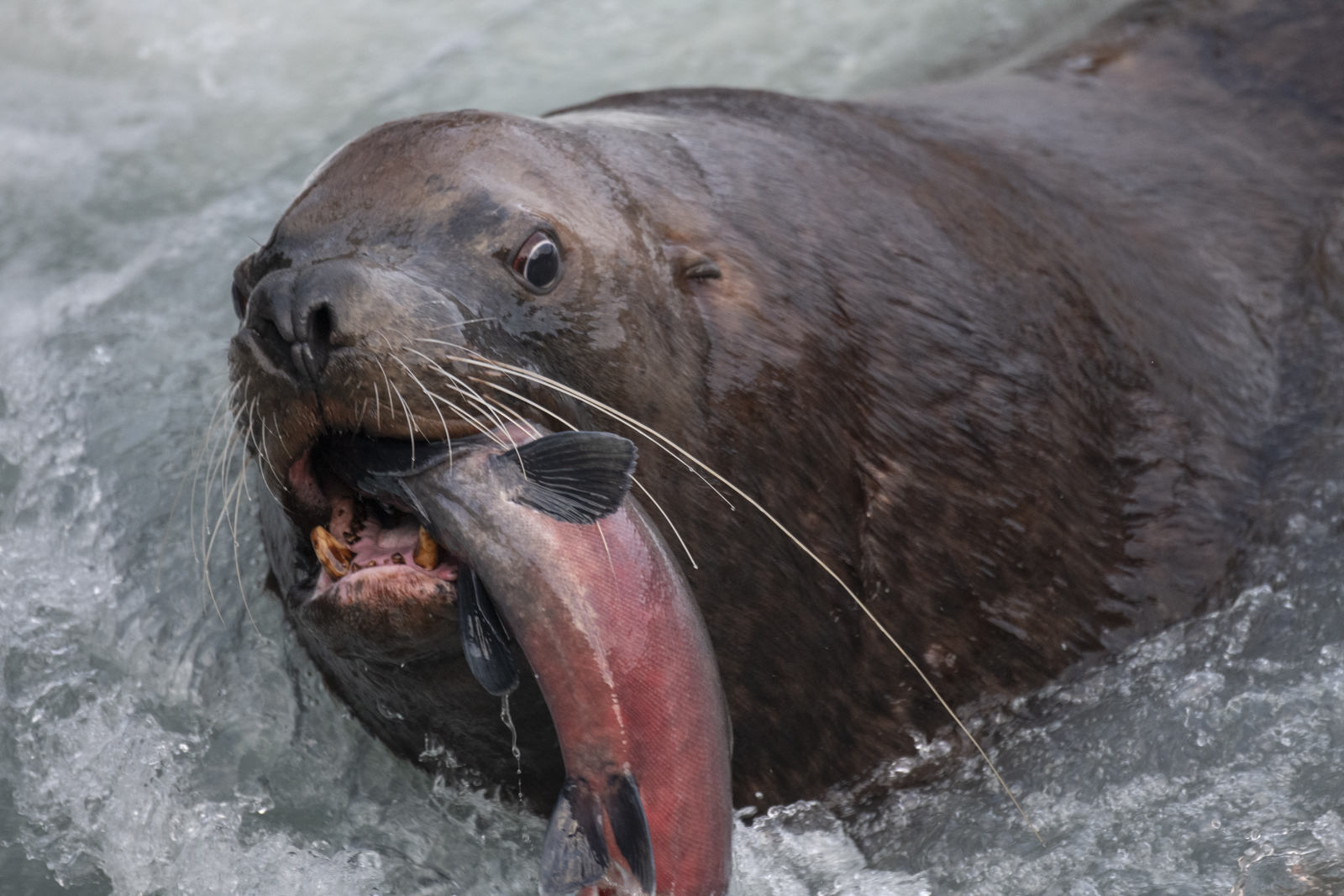 Stellar’s sea lion with spawning coho salmon.
Stellar’s sea lion with spawning coho salmon.
Wary of leaving the security of the Slana River, an adult beaver slowly approaches a scent mound. Interrupting an invisible beam, the beaver triggers a digital camera to capture this self portrait.
BEAVER BEHAVIOR
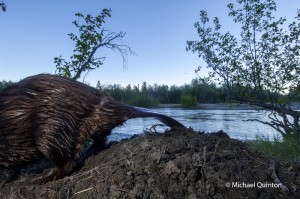 Hauling armloads of mud and moss, beavers continually add to their mounds and frequently add a fresh scent. Bulletin boards for beavers, scent mounds are important features of their territory. And a good place to set up a camera trap I thought. You know, just to see what might pass. Kind of a wildlife selfie station. I pick the place, they pick the time.
Hauling armloads of mud and moss, beavers continually add to their mounds and frequently add a fresh scent. Bulletin boards for beavers, scent mounds are important features of their territory. And a good place to set up a camera trap I thought. You know, just to see what might pass. Kind of a wildlife selfie station. I pick the place, they pick the time.
Once or twice a month this wandering lynx passed the lens.
Over the spring/summer months the camera had several views of this scent mound. To the beavers the camera was part of the scenery. I had nightmares of them chewing on the camera or even pulling the whole camtraption into the river. But they completely ignored it. Beavers sometimes used the mound as a feeding platform or to just sit and chill for a few minutes. A late night surprise, the south end of a northbound grizzly. (below)
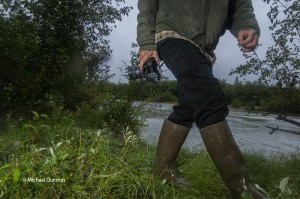 After a couple weeks of rainy weather I arrive at the camera station with a dry Nikon. The set-up is prone to problems. False triggers, battery failure, flash and sensor failure due to moisture, even snowshoe hares chewing cords. The beavers were busy refurbishing an old bare-bones lodge downstream and had all but stopped coming to the scent mound. But I kept the camera station operating. I like unexpected surprises.
After a couple weeks of rainy weather I arrive at the camera station with a dry Nikon. The set-up is prone to problems. False triggers, battery failure, flash and sensor failure due to moisture, even snowshoe hares chewing cords. The beavers were busy refurbishing an old bare-bones lodge downstream and had all but stopped coming to the scent mound. But I kept the camera station operating. I like unexpected surprises.
 A pair of gray jays have finished their nest by early April.
A pair of gray jays have finished their nest by early April.
I first saw the gray jays as they flew across the road in front of me. They both carried loads of building materials in their bills. The next day I went searching for their nest. It was rather easy to find as they were both busy with construction. The nest was about twenty feet high in a medium-sized black spruce. They had completed a loose bowl of dry spruce twigs and were currently engaged with stuffing this framework with insulation. The pair gathered black, grizzly hair lichens as well as spruce grouse feathers. But their most prized finds were the long soft plumes of the northern hawk owl. After delivering a load of insulation, the birds would hop into the nest and push with bills and feet as they rotated around in the nest, fitting and forming it to just the right shape. The female begins sitting on the nest and a week later her clutch of spotted eggs is complete. The pair is quiet at the nest site and does not attract attention of those nest raiders, magpies and ravens. When a red squirrel was spotted nearby it was dive-bombed by the male gray jay and driven away.
The female begins sitting on the nest and a week later her clutch of spotted eggs is complete. The pair is quiet at the nest site and does not attract attention of those nest raiders, magpies and ravens. When a red squirrel was spotted nearby it was dive-bombed by the male gray jay and driven away.
 For nearly three weeks the female incubated her four eggs. A few times a day she will leave the nest but only for a few minutes, perhaps to drink.
For nearly three weeks the female incubated her four eggs. A few times a day she will leave the nest but only for a few minutes, perhaps to drink.
 The male gray jay shows up at the nest about once an hour or so to feed his mate.
The male gray jay shows up at the nest about once an hour or so to feed his mate.
 Laying eggs is an energy drain and the female spends hours sleeping.
Laying eggs is an energy drain and the female spends hours sleeping.
 Early nesting grays jays must be able to handle cold, wet conditions in their Alaskan habitat.
Early nesting grays jays must be able to handle cold, wet conditions in their Alaskan habitat.
 Both adults help feed the quickly growing gray jay chicks. Gray jays store amazing amounts of food including carrion and I wondered if they would feed their cached supplies to their chicks. But Instead they foraged the ground for insects and larva, much better food for the new chicks.
Both adults help feed the quickly growing gray jay chicks. Gray jays store amazing amounts of food including carrion and I wondered if they would feed their cached supplies to their chicks. But Instead they foraged the ground for insects and larva, much better food for the new chicks.
 As the chicks grew the gray jays cached stores of carrion became more important. And it quickly became apparent that the nest would never hold four growing chicks for long. By the time the chicks were about two weeks old, they jostle for the best position at the nest. I witnessed deliberate attempts by the larger chicks to force their smaller siblings out. One morning there were just two chicks left in the nest. Below the nest on the ground were the missing chicks, both dead. From human eyes, a tragic event. But for nature, another one of those mysteries of survival.
As the chicks grew the gray jays cached stores of carrion became more important. And it quickly became apparent that the nest would never hold four growing chicks for long. By the time the chicks were about two weeks old, they jostle for the best position at the nest. I witnessed deliberate attempts by the larger chicks to force their smaller siblings out. One morning there were just two chicks left in the nest. Below the nest on the ground were the missing chicks, both dead. From human eyes, a tragic event. But for nature, another one of those mysteries of survival.
Come July of this year the name of the gray jay will change once again. They will officially be known as the Canada jay. And like camp robber and whiskey jack, gray jay will be just another nickname used to describe this gray-colored jay of the northern forests.
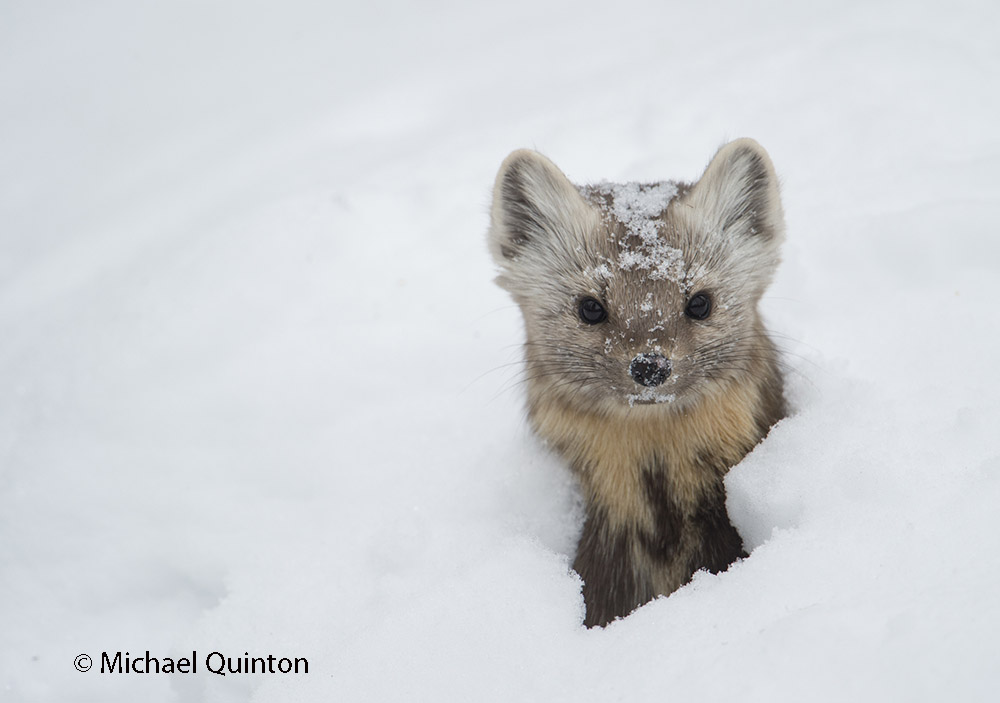 A marten pokes up through the snow to look around.
A marten pokes up through the snow to look around.
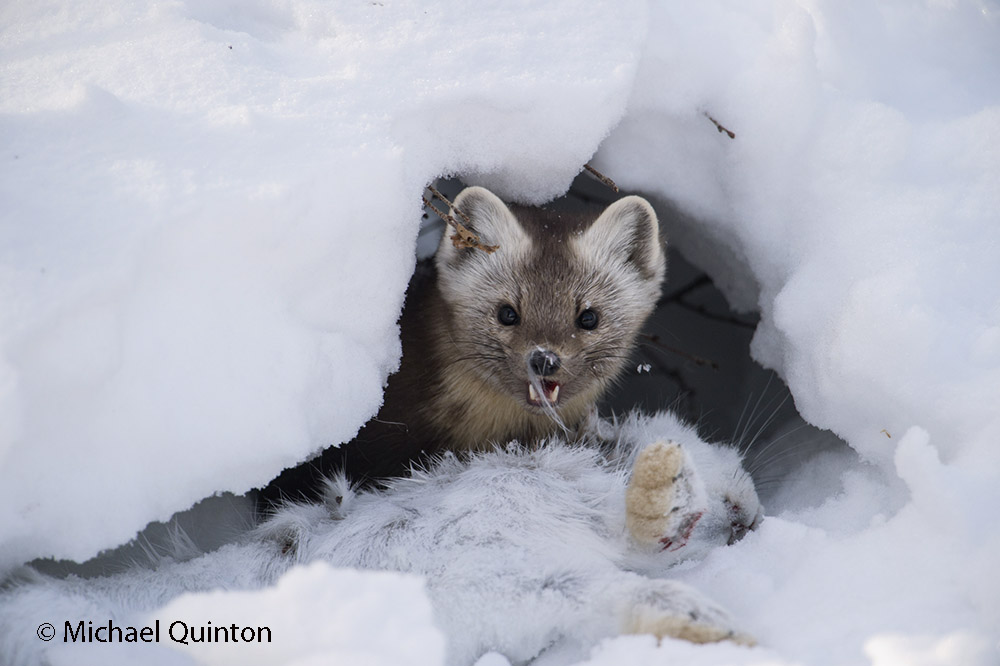 The shy and careful weasel, not liking to be exposed, has pulled its prey, a snowshoe hare, into deep snow.
The shy and careful weasel, not liking to be exposed, has pulled its prey, a snowshoe hare, into deep snow.
 Though I have gone several years between marten sightings in the past, i typically have one or two sightings a year. But, just last week we had a marten hanging out at our place for several days. The forest around our home was laced with its familiar tracks and all the trails seemed to begin at a big wood pile like spokes of a wheel. We saw it several times daily and I was able to take hundreds of photographs of the usually elusive predator. From our front row seat at the window, we watched as the marten climbed up a spruce to a red squirrel nest and stole goodies the squirrel had stashed there. And, once I watched as it chased a snowshoe hare through the black spruce. It managed an amazing burst of speed and very nearly caught up to the hare. But when pressed the hare showed he is even quicker So, I was a bit surprised to look out the window and see the marten tugging and pulling at a hare it had caught during the night. It pulled the hare into the deep snow where it could butcher its prey concealed from the prying eyes of other predator and scavengers. First the marten gnawed off the hares head and cached it in the wood pile. The next day it cached the hares front legs. Cindy and I watched as the solitary marten entertained itself by running an obstacle course around and through the wood pile then roll on its back in the snow.
Though I have gone several years between marten sightings in the past, i typically have one or two sightings a year. But, just last week we had a marten hanging out at our place for several days. The forest around our home was laced with its familiar tracks and all the trails seemed to begin at a big wood pile like spokes of a wheel. We saw it several times daily and I was able to take hundreds of photographs of the usually elusive predator. From our front row seat at the window, we watched as the marten climbed up a spruce to a red squirrel nest and stole goodies the squirrel had stashed there. And, once I watched as it chased a snowshoe hare through the black spruce. It managed an amazing burst of speed and very nearly caught up to the hare. But when pressed the hare showed he is even quicker So, I was a bit surprised to look out the window and see the marten tugging and pulling at a hare it had caught during the night. It pulled the hare into the deep snow where it could butcher its prey concealed from the prying eyes of other predator and scavengers. First the marten gnawed off the hares head and cached it in the wood pile. The next day it cached the hares front legs. Cindy and I watched as the solitary marten entertained itself by running an obstacle course around and through the wood pile then roll on its back in the snow.
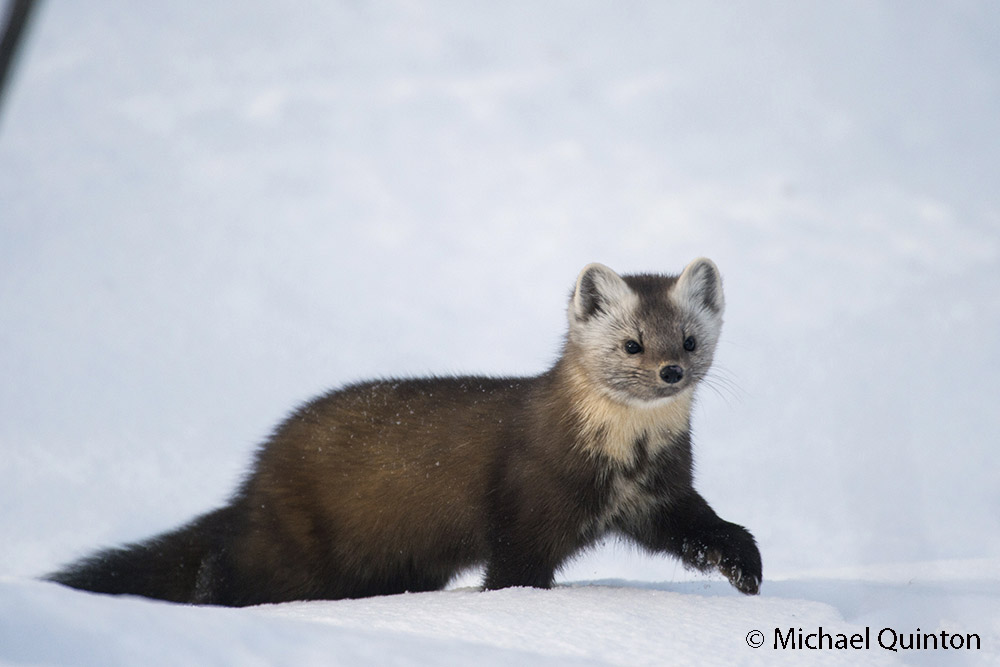 Though half the snowshoe hare was still left I spent the next two days watching and waiting for it to reappear. But just like it appeared, it disappeared. A pair of gray jays began to work the hare carcass hauling if away piece by piece, stashing it among the black spruce boughs. A pair of ravens wanted their share but only stared. For ravens, of course, are very cautious, even fearing their own food. But ravens are keen spies and watched carefully where the gray jays cached their loads. A hawk owl made a lightning quick chase and near miss of one of the gray jays. And later, I saw it swoop quickly again in the vicinity of the snowshoe hare carcass. Thinking it might have caught the gray jay I approached with my camera and telephoto lens. But the hawk owl had not caught the jay, instead it stood on the snowshoe hare carcass tugging. From the thick spruce nearby I heard a second hawk owl calling. It was the begging call of a female. After several minutes of biting and pulling the hawk owl, presumably a male, managed to tear off a chunk of the hare. It flew to a spruce and was soon joined by the female who took the offering.
Though half the snowshoe hare was still left I spent the next two days watching and waiting for it to reappear. But just like it appeared, it disappeared. A pair of gray jays began to work the hare carcass hauling if away piece by piece, stashing it among the black spruce boughs. A pair of ravens wanted their share but only stared. For ravens, of course, are very cautious, even fearing their own food. But ravens are keen spies and watched carefully where the gray jays cached their loads. A hawk owl made a lightning quick chase and near miss of one of the gray jays. And later, I saw it swoop quickly again in the vicinity of the snowshoe hare carcass. Thinking it might have caught the gray jay I approached with my camera and telephoto lens. But the hawk owl had not caught the jay, instead it stood on the snowshoe hare carcass tugging. From the thick spruce nearby I heard a second hawk owl calling. It was the begging call of a female. After several minutes of biting and pulling the hawk owl, presumably a male, managed to tear off a chunk of the hare. It flew to a spruce and was soon joined by the female who took the offering.
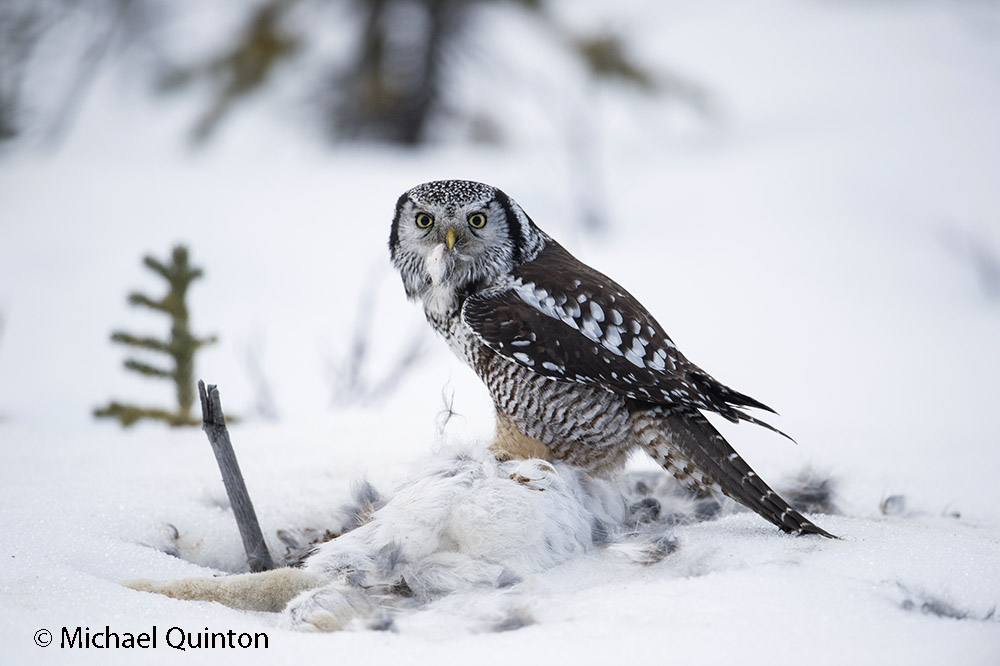 Northern hawk owl continues the butchering process of the marten’s kill. Though It is true that a predator may not use all of its prey, nothing is wasted.
Northern hawk owl continues the butchering process of the marten’s kill. Though It is true that a predator may not use all of its prey, nothing is wasted.
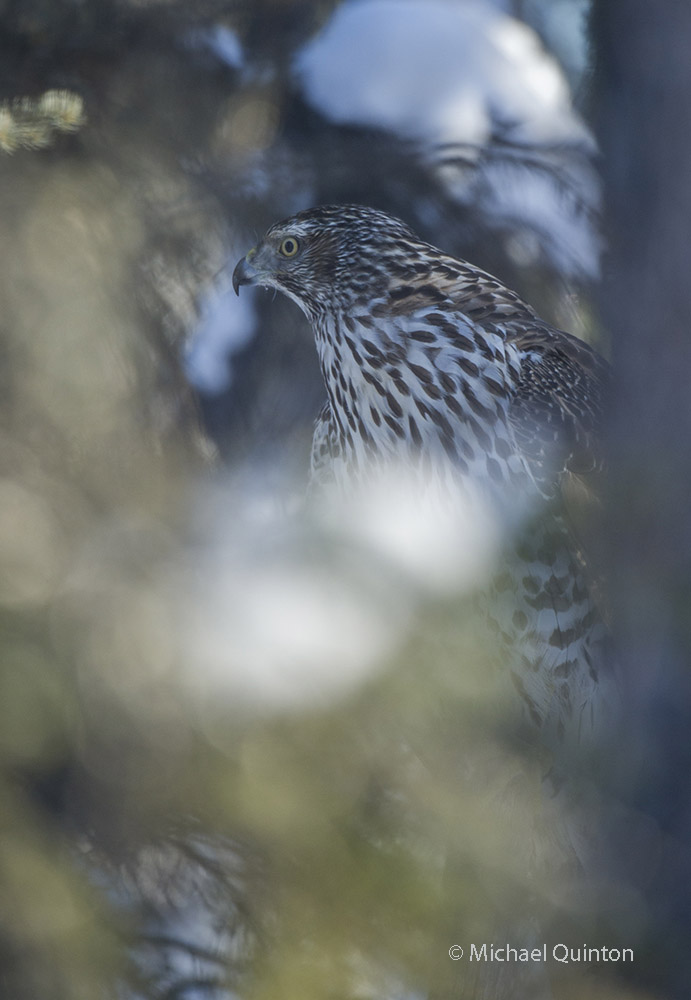 From a perch in a stand of stunted black spruce, a well camouflaged immature northern goshawk stalks its prey. Their short, wide wings and long tail give it both speed and manoeuverability to pursue prey in the forest. No small bird or mammal is safe from a sudden ambush, but this winter the large accipiters key on snowshoe hares.
From a perch in a stand of stunted black spruce, a well camouflaged immature northern goshawk stalks its prey. Their short, wide wings and long tail give it both speed and manoeuverability to pursue prey in the forest. No small bird or mammal is safe from a sudden ambush, but this winter the large accipiters key on snowshoe hares.
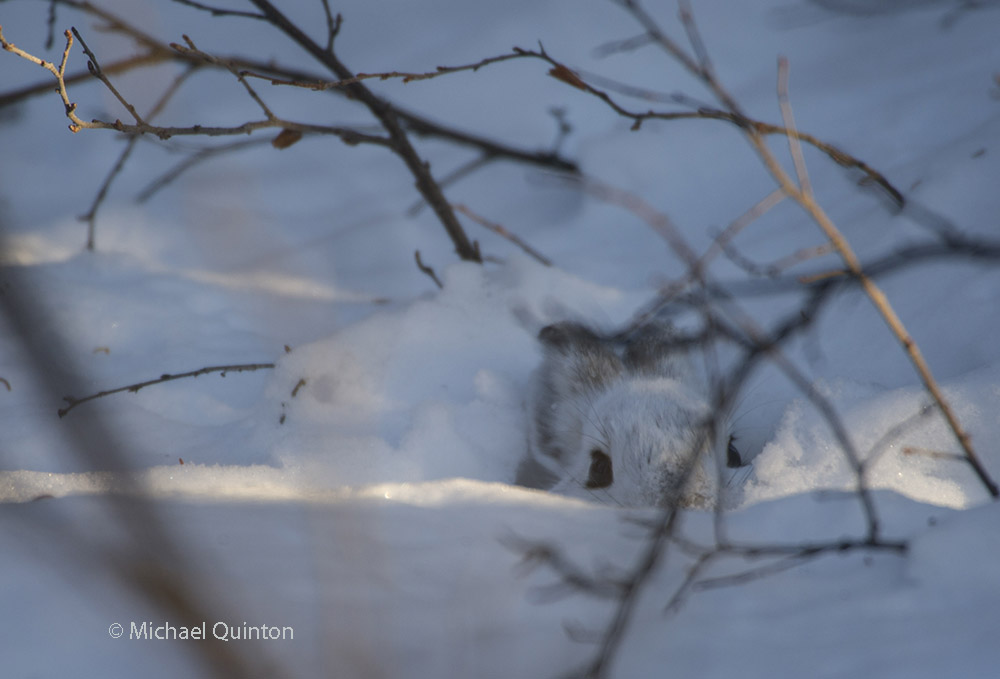 The snowshoe hare has perfected the art of camouflage, but as an extra defense against the goshawks, they often use snow burrows. But the snowshoe hares’ best defense against the sudden attacks by goshawks is its nocturnal behavior.
The snowshoe hare has perfected the art of camouflage, but as an extra defense against the goshawks, they often use snow burrows. But the snowshoe hares’ best defense against the sudden attacks by goshawks is its nocturnal behavior.
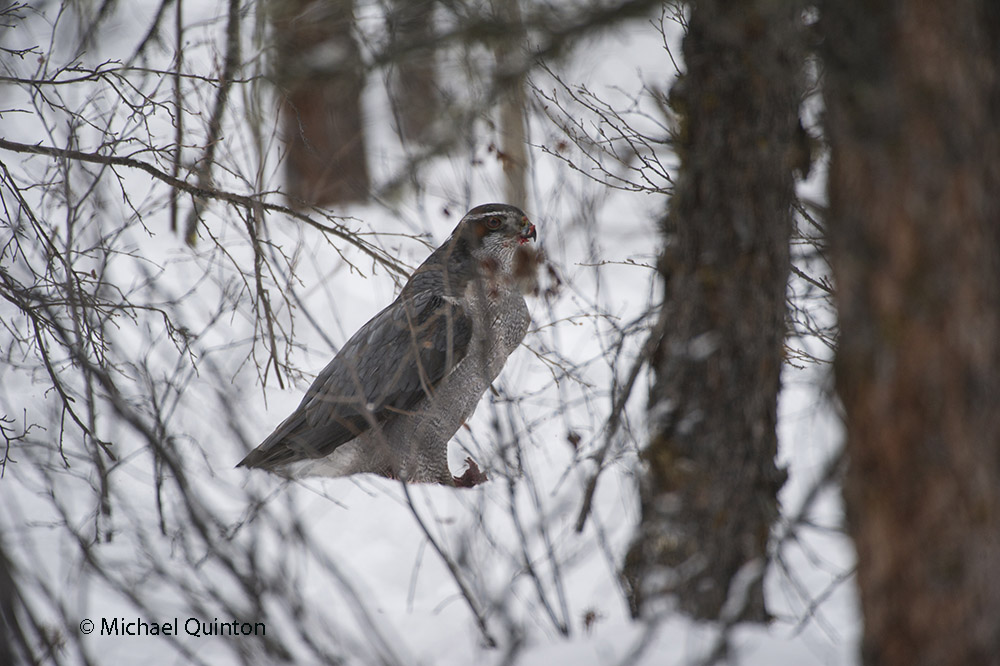 An adult northern goshawk feeds on a snowshoe hare.
An adult northern goshawk feeds on a snowshoe hare.
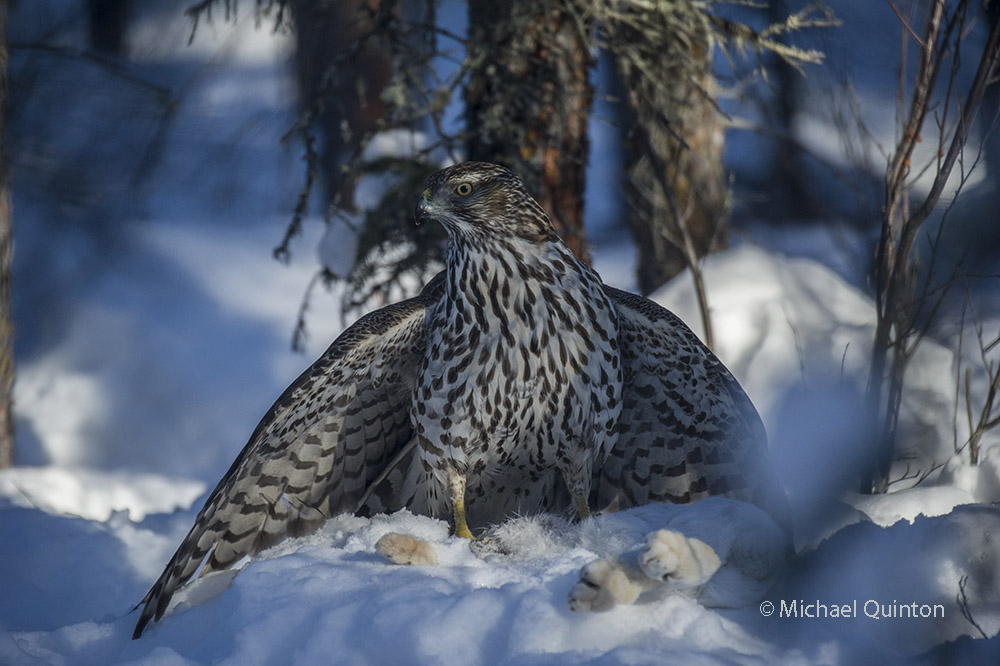 As I photographed a snowshoe hare this immature northern goshawk suddenly appeared out of the blue shadows and killed my photo subject. She mantles her prey with powerful wings.
As I photographed a snowshoe hare this immature northern goshawk suddenly appeared out of the blue shadows and killed my photo subject. She mantles her prey with powerful wings.
 Often northern goshawks show little fear of humans. When I approached it flew a few yards away but quickly returned to its prey. The goshawk fed for nearly an hour leaving only the feet, fur, guts, head and large bones.
Often northern goshawks show little fear of humans. When I approached it flew a few yards away but quickly returned to its prey. The goshawk fed for nearly an hour leaving only the feet, fur, guts, head and large bones.
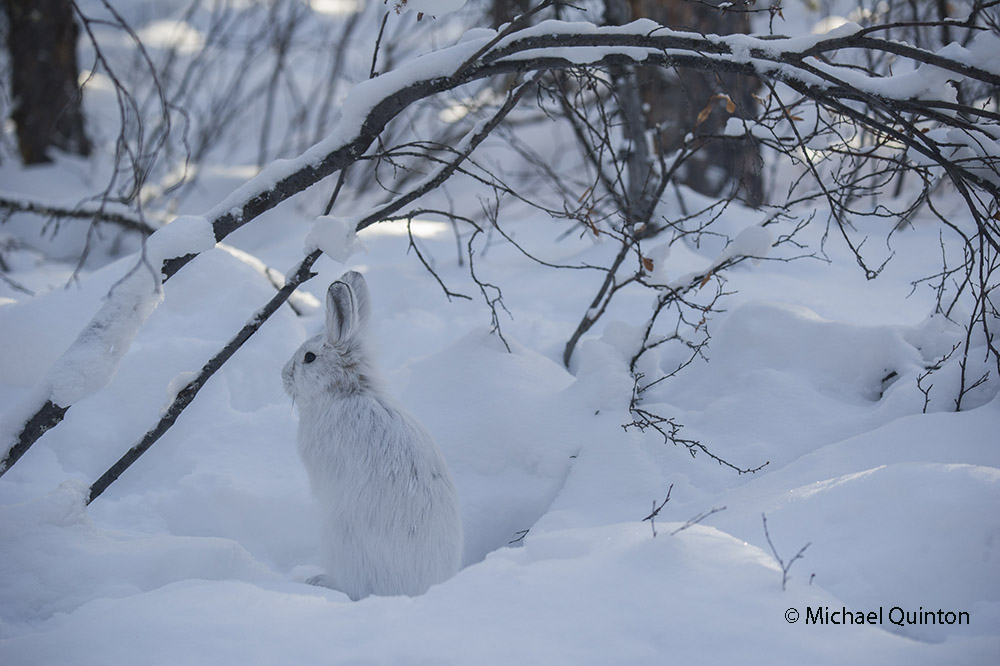 While the snowshoe hare population is near its peak this year, their primary predators populations (northern goshawk, lynx, coyote and great horned owl) are also peaking. And this heavy predation will inevitably cause the next snowshoe hare population crash.
While the snowshoe hare population is near its peak this year, their primary predators populations (northern goshawk, lynx, coyote and great horned owl) are also peaking. And this heavy predation will inevitably cause the next snowshoe hare population crash.
 For months, over two nesting seasons I spent nearly every day in the company of northern goshawks. Slowly they would reveal their secret lives.
For months, over two nesting seasons I spent nearly every day in the company of northern goshawks. Slowly they would reveal their secret lives.
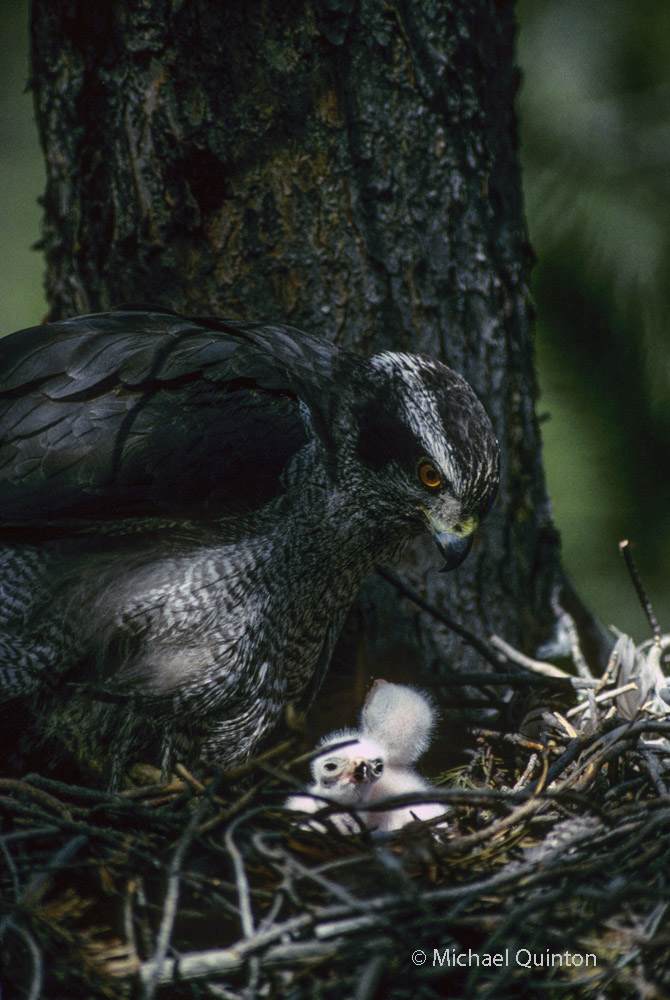 High in the canopy a female tends to her day old chicks.
High in the canopy a female tends to her day old chicks.
After the chicks hatch, northern goshawks become very aggressive at their nests. By visiting the nesting territory on a daily basis, starting early in the nesting season I seemed to have gained the trust of the goshawks. By building my blind near their nest under the cover of darkness, wearing the same clothes everyday and never disturbing the nest, I was able to climb into my photo blind or walk around the forest below unmolested.
The great female goshawk rose up from her eggs and stepped to the edge of her three-foot wide nest. Eyes of blood locked onto her target. Diving headfirst off the nest, she pumped her wings quickly accelerating to attack speed. Long tail feathers flared and pivot, sending the goshawk speeding around the base of a large douglas fir and crashing into the understory. Squealing in terror, a red squirrel jumped to the trunk and instinctively darted to the opposite side, sticking like velcro to the rough, dry bark, then squirrel shot up the trunk into the canopy. Again the goshawk attacked. Going up, the squirrel was faster but on the way back down the goshawk closed the distance.
Among the thick branches of the canopy the squirrel had the edge, but not by much. Using feet, bill and wings, the goshawk literally swam through the boughs. Desperate to lose the hawk, the squirrel spiraled up the nest tree and right over those precious eggs, before jumping to an adjacent tree. The squirrel somehow missed being snagged by those talons, utilizing unearthly tricks of speed and anti-gravity. I could keep track of the chase through the various observation and lens slits cut into the photo blind, but the action was much too quick and hard to follow so I missed getting any photos. It was inevitable I guess, when I felt the squirrel coming up my blind tree, the gos riding his wind. A vision of the squirrel taking refuge up my pant leg was suddenly a painful possibility. Just as the squirrel shot inside the blind I yelled and smacked the side of the blind. Luck was cheap that June morning. After a couple of quick laps around the legs of me and my tripod, the squirrel dashed back out and jumped to the next tree about five feet away.
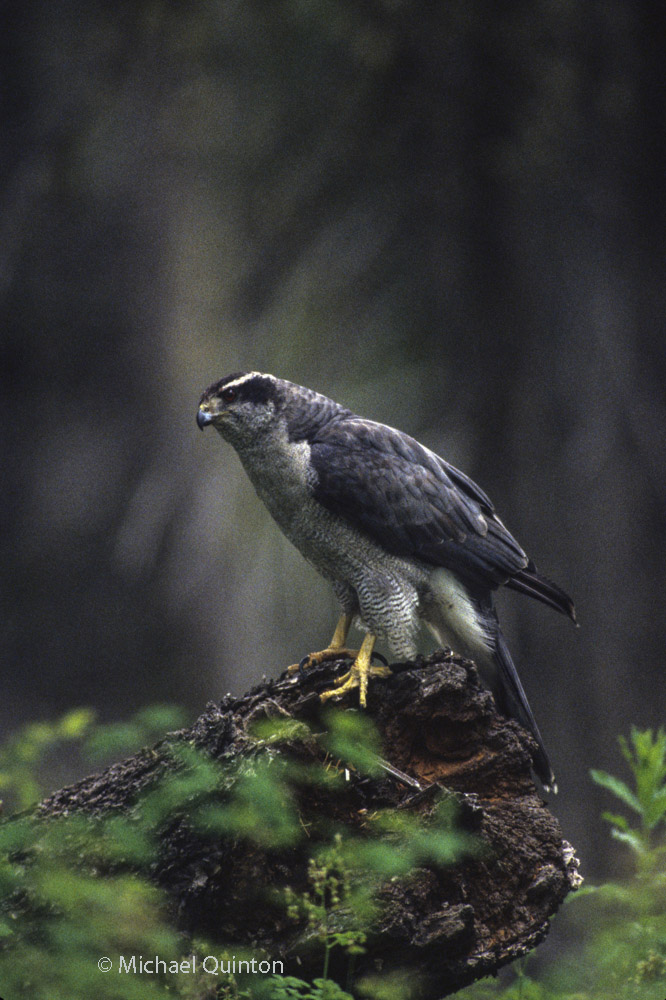 Slamming through the branches with little regard for its plumage, the gos didn’t let up. But the squirrel had a little luck of his own stashed away. Running headfirst down the trunk, the squirrel made an Olympic jump 25 feet from the ground. Bouncing off the forest floor the squirrel made for thicker scenery. After orbiting several more big trees and an amazing sling-shot the squirrel made it to a thick jungle of downfall. For the next 30 minutes, the goshawk perched 20 feet below her nest and preened. The squirrel barked, chattered and buzzed and told the world what he thought of goshawks nesting in his five acres.
Slamming through the branches with little regard for its plumage, the gos didn’t let up. But the squirrel had a little luck of his own stashed away. Running headfirst down the trunk, the squirrel made an Olympic jump 25 feet from the ground. Bouncing off the forest floor the squirrel made for thicker scenery. After orbiting several more big trees and an amazing sling-shot the squirrel made it to a thick jungle of downfall. For the next 30 minutes, the goshawk perched 20 feet below her nest and preened. The squirrel barked, chattered and buzzed and told the world what he thought of goshawks nesting in his five acres.
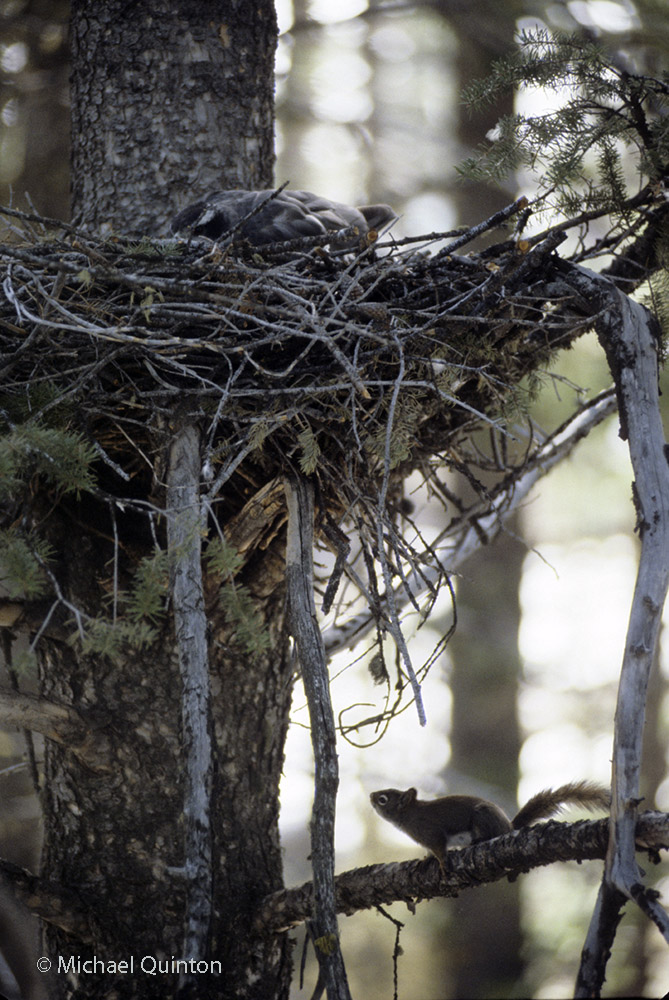 Three weeks earlier, the goshawk had calmly sat on her eggs while this same squirrel climbed the nest tree, dug into the bottom of the nest to find and nibble on mushrooms. I guess it seemed like the perfect place to dry mushrooms.
Three weeks earlier, the goshawk had calmly sat on her eggs while this same squirrel climbed the nest tree, dug into the bottom of the nest to find and nibble on mushrooms. I guess it seemed like the perfect place to dry mushrooms.
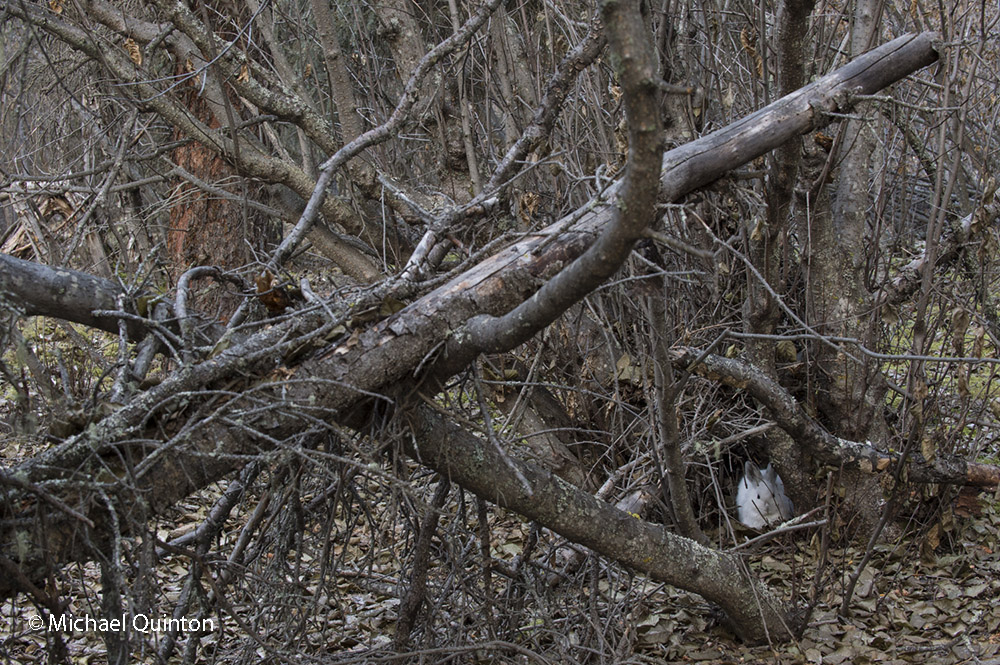 Winter seems to come later and later these past few years. And when that happens the local snowshoe hares are left feeling a bit conspicuous against their drab brown and gray habitat. The snowshoe hares count on their turn coats (brown in summer and white in winter) to help them hide from a gauntlet of predators like lynx, marten, red fox, northern goshawk, great hornedowls to name just a few.
Winter seems to come later and later these past few years. And when that happens the local snowshoe hares are left feeling a bit conspicuous against their drab brown and gray habitat. The snowshoe hares count on their turn coats (brown in summer and white in winter) to help them hide from a gauntlet of predators like lynx, marten, red fox, northern goshawk, great hornedowls to name just a few.
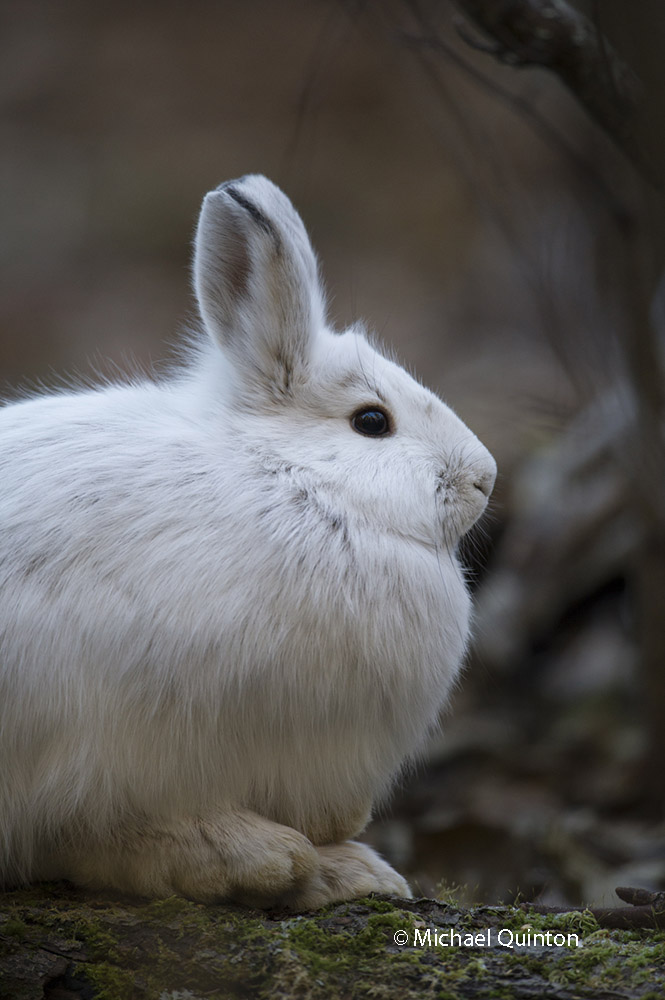 Normally shy, snowshoe hares may tire of dodging my efforts to photograph them after a few attempts and eventually allow me a few close-up shots.
Normally shy, snowshoe hares may tire of dodging my efforts to photograph them after a few attempts and eventually allow me a few close-up shots. 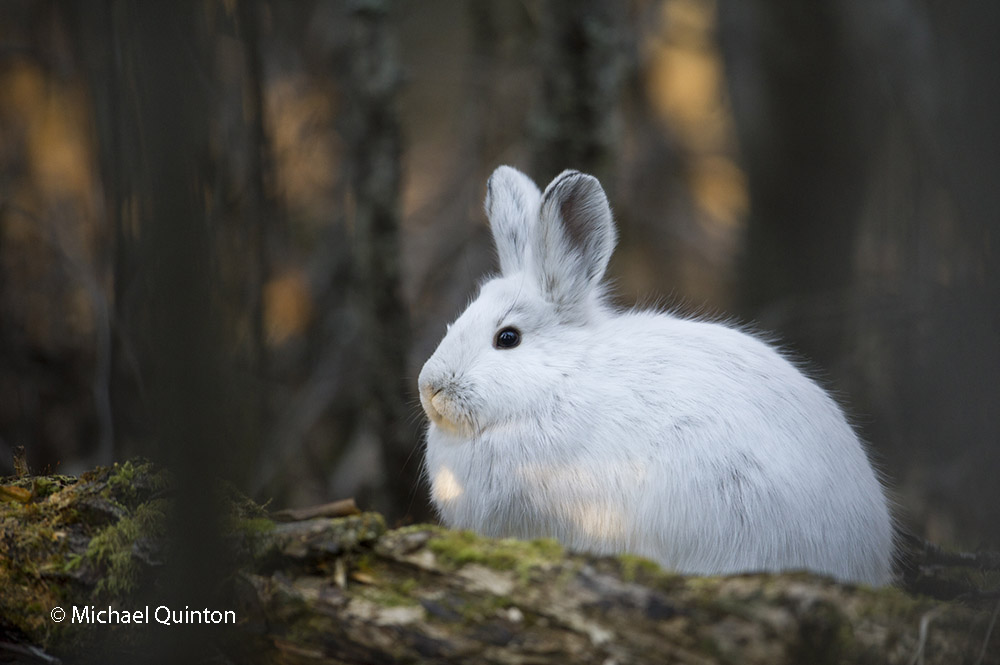 But days of white snowshoes in their snowless habitat are numbered. Snow is inevitable and soon they will be hiding in plain sight just as nature intended,
But days of white snowshoes in their snowless habitat are numbered. Snow is inevitable and soon they will be hiding in plain sight just as nature intended,
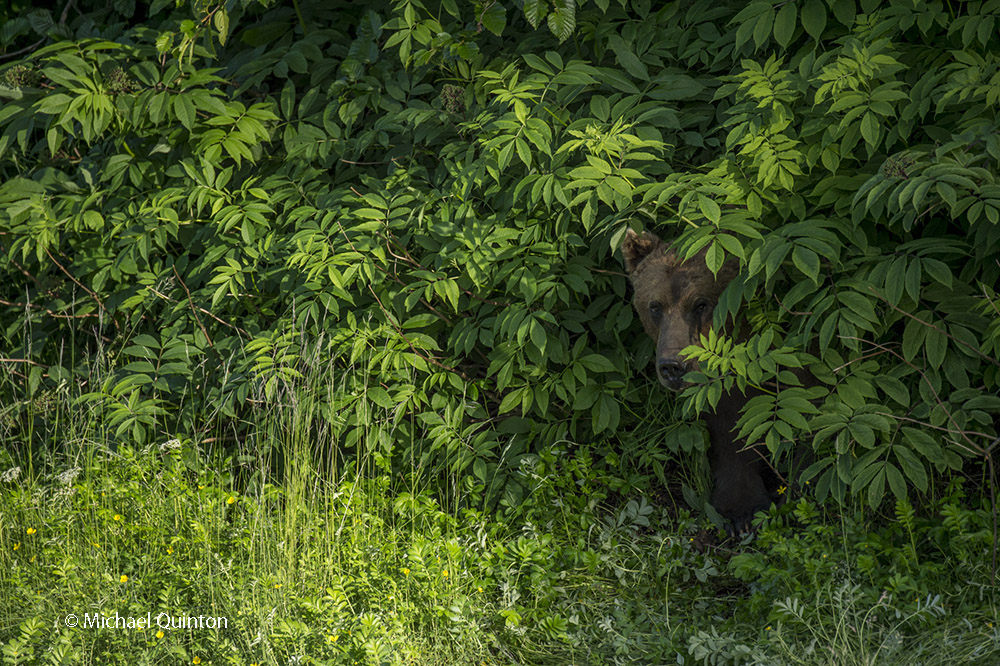 Sneaking a peek from the thicket of salmon berry and mountain ash a brown bear checks to see if the coast is clear. The bruin wants to get to the spawning pink salmon but is often kept away by a herd of nosy and noisy bad mannered tourists. When the bear does arrive, rather than giving the bear plenty of room to feed, tourists often crowd the bear hastening his departure before he has had his fill.
Sneaking a peek from the thicket of salmon berry and mountain ash a brown bear checks to see if the coast is clear. The bruin wants to get to the spawning pink salmon but is often kept away by a herd of nosy and noisy bad mannered tourists. When the bear does arrive, rather than giving the bear plenty of room to feed, tourists often crowd the bear hastening his departure before he has had his fill.
Left: Soloman Gulch
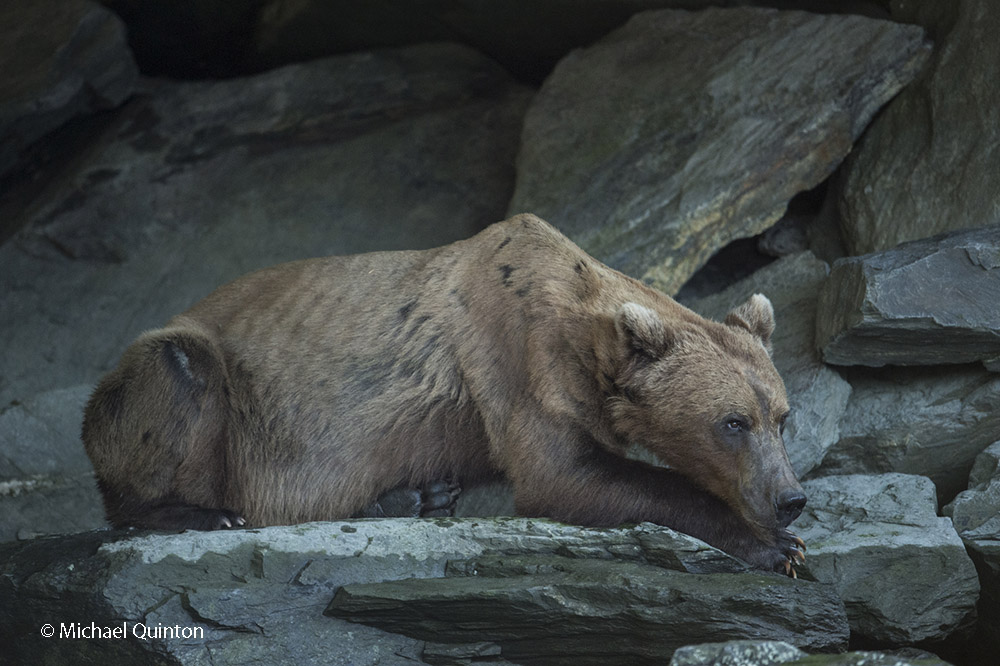 The brown bear, hungry but shy pauses as he works up the courage to approach the salmon and the tourists. This reluctance is something I share with the big brown bear.
The brown bear, hungry but shy pauses as he works up the courage to approach the salmon and the tourists. This reluctance is something I share with the big brown bear.
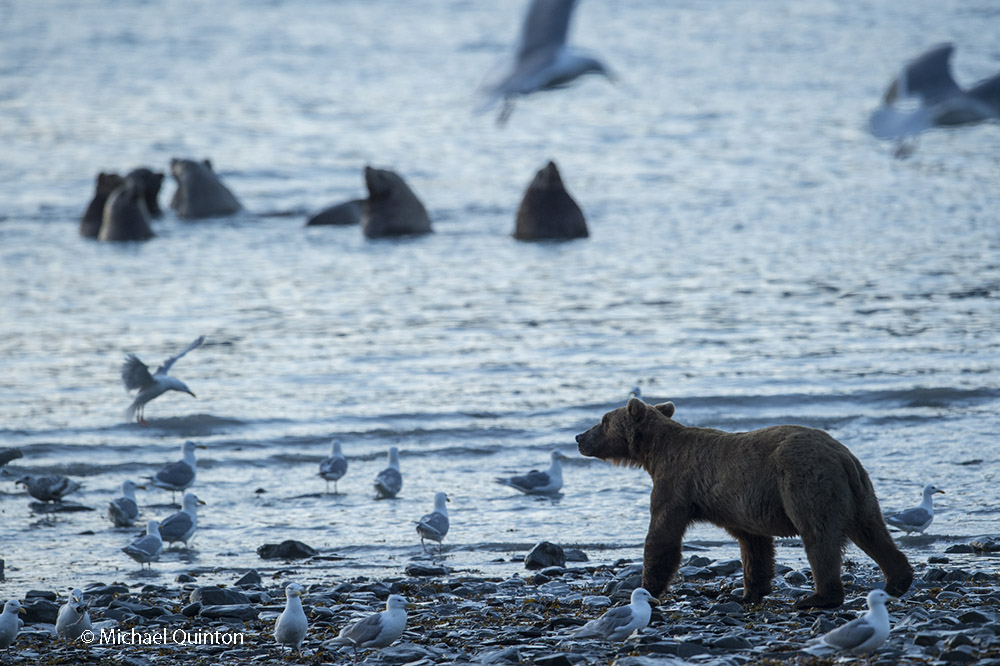 As the tide moves out exposing fish killed by feeding Stellar’s sea lions, the lanky brown bear cleans up. The Stellar’s sea lions, are afraid of the bear and move away from shore.
As the tide moves out exposing fish killed by feeding Stellar’s sea lions, the lanky brown bear cleans up. The Stellar’s sea lions, are afraid of the bear and move away from shore.
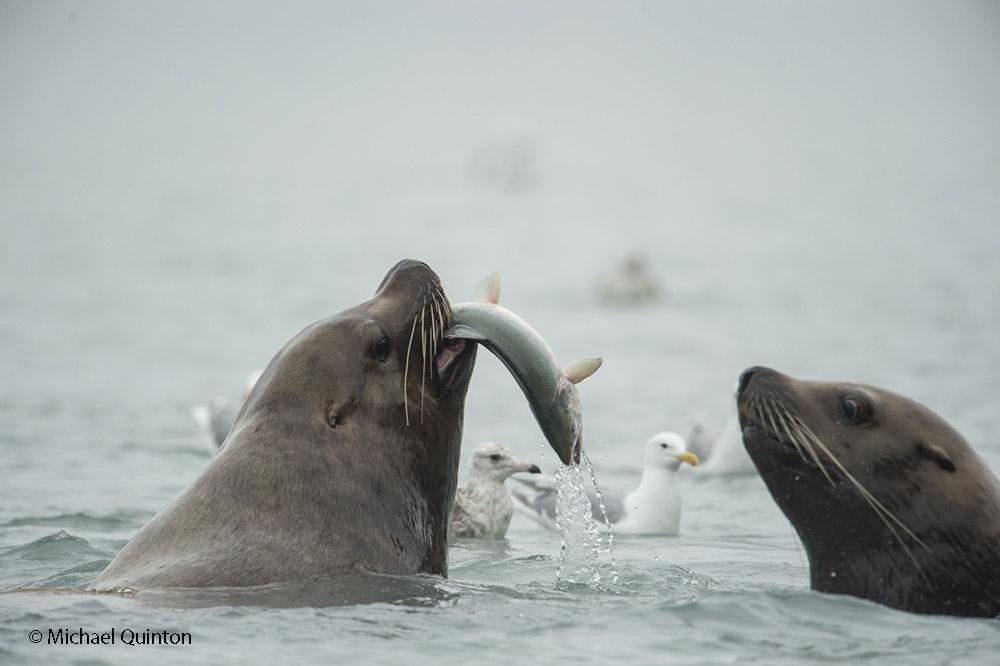 Like the brown bear, Stellar’s sea lions come to Soloman Gulch to feed on the millions of pink salmon arriving here to spawn. Over the past twenty -five years, I have witnessed an increasing number of Sellar’s sea lions spending the first week of July near the mouth of Soloman Gulch. This year I counted over one hundred sea lions together at a nearby resting site during low tide.
Like the brown bear, Stellar’s sea lions come to Soloman Gulch to feed on the millions of pink salmon arriving here to spawn. Over the past twenty -five years, I have witnessed an increasing number of Sellar’s sea lions spending the first week of July near the mouth of Soloman Gulch. This year I counted over one hundred sea lions together at a nearby resting site during low tide.
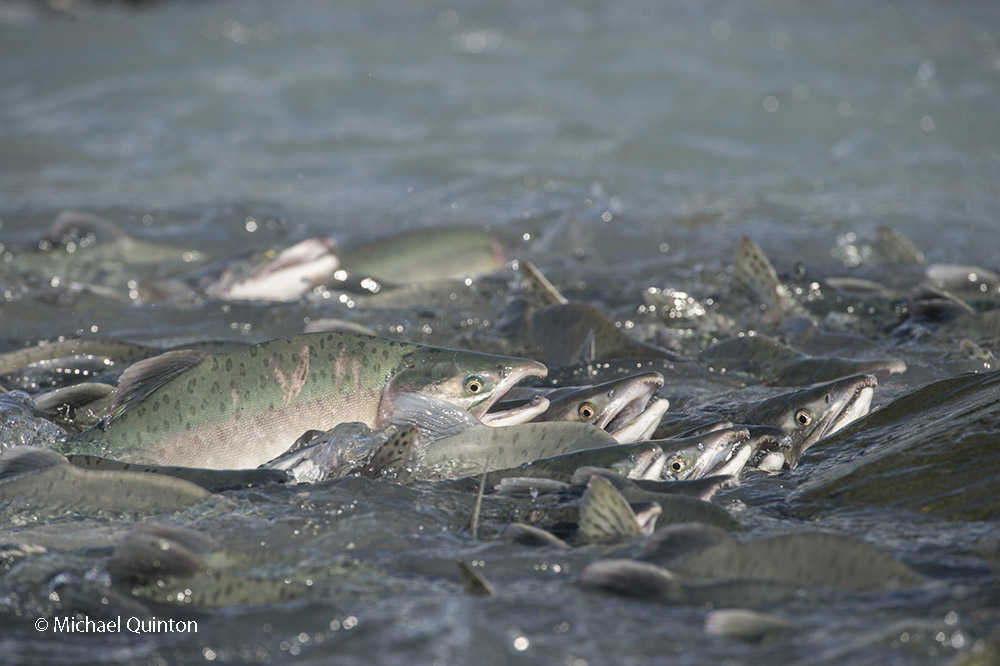 Pink salmon by the millions arrive at the mouth of Soloman Gulch to spawn.
Pink salmon by the millions arrive at the mouth of Soloman Gulch to spawn.
A stellar’s sea lion bites a pink salmon in half. This is a common technique used by some of the sea lions. I overheard some guy telling his wife that they bite them in half so they can swallow the fish in two pieces. But what actually is happening is a bit different. Like the bears, the lea lions soon tire of a straight diet of salmon and quickly begin to be more selective. What they want more than anything are the eggs. That’s why both bears and sea lions both often drop the males soon often they are caught. When a sea lion catches an egg-laden female salmon they may bite hard at the head end of the fish then violently jerk the fish to the side, ripping it in half and keeping the salmon head and guts along with the eggs in its mouth. The photo above shows the sea lion had the wrong end of the salmon and was left with just a tail. Visitors often comment on how wasteful the sea lions are but nothing really goes to wast. Bears, gulls, bald eagles, sea otters, harbor seals get what the sea lions leave behind, not to mention all the other hungry fish and crabs and other marine scavengers.
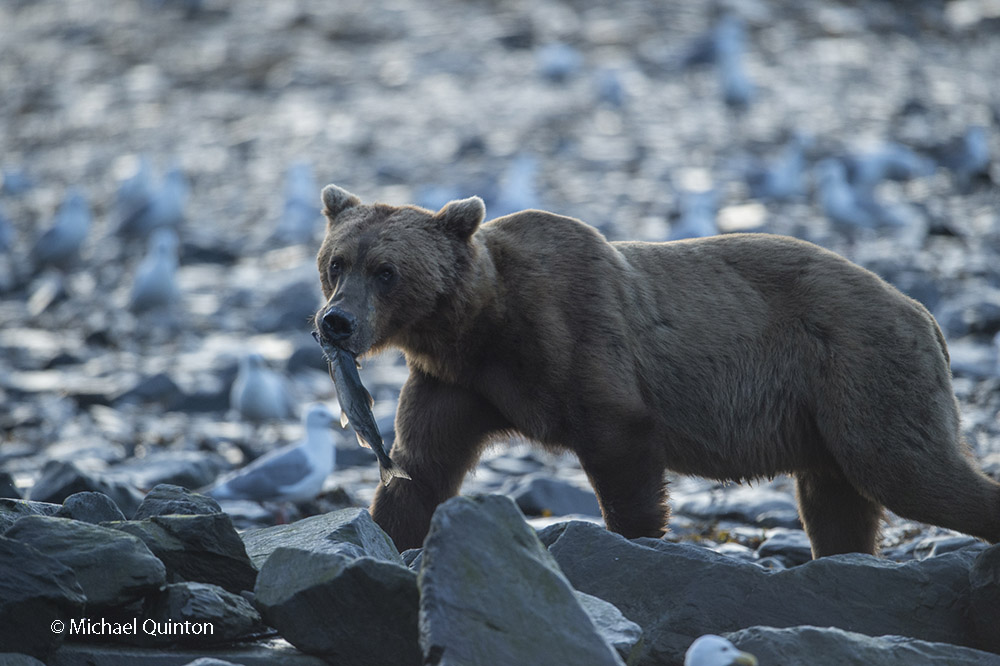 The brown bear grabs a small salmon and carries it back to the seclusion of Soloman Gulch.
The brown bear grabs a small salmon and carries it back to the seclusion of Soloman Gulch.